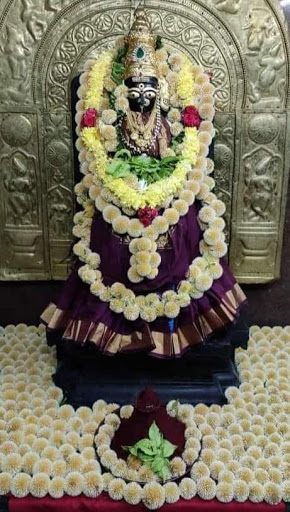With nama 133, the description of Her act of benediction ends.
From 134 to 155, the namas describe Lalithambika as Nirguna Brahman ( Her formless form). Worshipping Her as Nirguna Brahman is an important aspect of Saktha worship. The significance of all these namas (132 - 155, except 141) is the usage of prefixes nis or nir (negation). Brahman has been qualified by negation of sensory perceptions.
निर्लेपा (134)
Nirlepā
She is without attachments. Lepā means stain or pollution which is impure. Attachment is caused by bondage and bondage is the result of karma-s. Karma-s arise out of actions. She is beyond karma-s arising out of actions.
निर्मला (135)
Nirmalā
Mala means dirt arising out of impure matter. Mala is a sense of imperfection that leads to ignorance about the soul and hampers the free expression of the Supreme Self. This ignorance is caused by ego which is called mala. She is without such dirt.
नित्या (136)
Nityā
Nitya means eternal and without changes.
Nitya is said to be the highest object of worship and the ultimate philosophical principle in kula system. The world kula stands for Śaktī.
निराकारा (137)
Nirākārā
She is formless. Ākāra means form, figure, shape, etc.
निराकुला (138)
Nirākulā
She is without agitation. Ākulā means confounded, confused, agitated, flurried, or disordered. Nir negates all that is meant by ākulā.
निर्गुणा (139)
Nirguṇā
Guṇa can be interpreted as constituent qualities. There are three kinds of guṇa -s. They are sattva, rajas and tamas. Sattva guṇa means quality of purity and knowledge. Rajo guṇa means activity and passion. Tamo guṇa means inertia and ignorance.
She is unconditioned with these guṇa-s since She does not have a gross body. Therefore She is called nirguṇa.
निष्कला (140)
Niṣkalā
She is without bodily parts. This nāma is an extension of the previous one. Because of being nirguṇa, She is niṣkalā. Kalā means parts.
शन्ता (141)
Śantā
This nāma means that She is calm and tranquil. Tranquillity is considered as an essential quality for self-realization.
निष्कामा (142)
Niṣkāmā
She is without desire.
निरुपप्लवा (143)
Nirupaplavā
This nāma is split into nir (the word nir has many meanings and in this context, it means body) + upa (approaching) + plavā (dripping). This means that when Kuṇḍalinī approaches sahasrāra the ambrosia starts dripping into the body system. This refers to Her subtlest Kuṇḍalinī form.
नित्य-मुक्ता (144)
Nitya-muktā
She is eternally free, another quality of the Brahman.
निर्विकारा (145)
Nirvikārā
She is devoid of modifications (vikāra means modification). Brahman does not change.
निष्प्रपञ्चा (146)
Niṣprapañcā
Prapañca means expansion, development or manifestation. She is without such attributes. Since the Brahman is ādhi (the first) and anādhi (without parentage) it is beyond any modifications or changes
निराश्रया (147)
Nirāśrayā
Āśraya means dependence. She does not depend on anything. She being the Brahman does not depend upon anything and on the contrary, everything depends upon Her.
नित्य-शुद्धा (148)
Nitya-śuddhā
She is eternally pure.
नित्य-बुद्धा (149)
Nitya-buddhā
She is eternally wise. She's the self-Illuminating intelligence.
निरवद्या (150)
Niravadhyā
She is inviolable and without defects. Avadhyā means incapable of being transgressed or dishonoured.
निरन्तरा (151)
Nirantarā
She will neither divide nor multiply, as He does not change. She is permanent.
निष्कारणा (152)
Niṣkāraṇā
She is without cause.
She is the cause for the universe.
निष्कलङ्का (153)
Niṣkalaṅkā
She is without any stains. Stains arise out of sins.
निरुपाधिः (154)
Nirupādhiḥ
She is without upādhi. Upādhi means limitations.
नीरीश्वरा (155)
Nīriśvarā
Iśvara means superior or master. She does not have a superior. She is the Supreme ruler.
With this nāma the description of qualities of Her nirguṇa Brahman form ends.





No comments:
Post a Comment